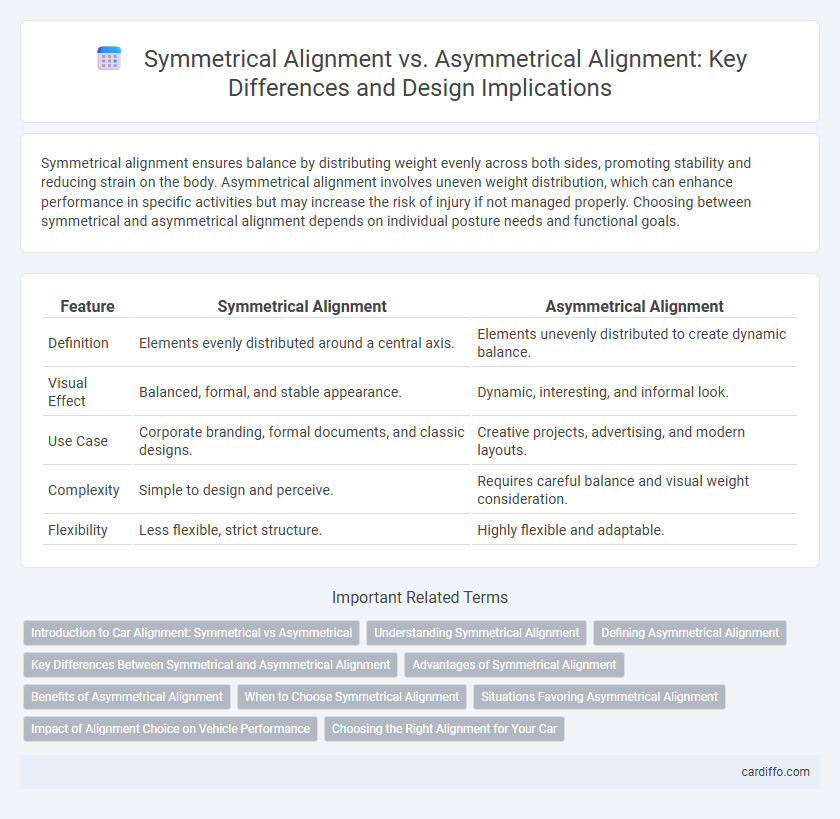Symmetrical alignment ensures balance by distributing weight evenly across both sides, promoting stability and reducing strain on the body. Asymmetrical alignment involves uneven weight distribution, which can enhance performance in specific activities but may increase the risk of injury if not managed properly. Choosing between symmetrical and asymmetrical alignment depends on individual posture needs and functional goals.
Table of Comparison
| Feature | Symmetrical Alignment | Asymmetrical Alignment |
|---|---|---|
| Definition | Elements evenly distributed around a central axis. | Elements unevenly distributed to create dynamic balance. |
| Visual Effect | Balanced, formal, and stable appearance. | Dynamic, interesting, and informal look. |
| Use Case | Corporate branding, formal documents, and classic designs. | Creative projects, advertising, and modern layouts. |
| Complexity | Simple to design and perceive. | Requires careful balance and visual weight consideration. |
| Flexibility | Less flexible, strict structure. | Highly flexible and adaptable. |
Introduction to Car Alignment: Symmetrical vs Asymmetrical
Symmetrical alignment ensures equal camber, caster, and toe angles on both sides of the vehicle, promoting even tire wear and balanced handling. Asymmetrical alignment adjusts these angles differently on each side to optimize performance based on vehicle design, load distribution, and driving conditions. Understanding the differences between symmetrical and asymmetrical alignment helps improve steering stability, tire longevity, and overall driving safety.
Understanding Symmetrical Alignment
Symmetrical alignment refers to the balanced arrangement of elements on either side of a central axis, creating visual harmony and stability. It promotes clear organization and easy readability by evenly distributing weight and spacing, which is crucial in design and layout. This type of alignment enhances user experience by providing a predictable and aesthetically pleasing structure.
Defining Asymmetrical Alignment
Asymmetrical alignment occurs when elements are arranged unevenly around a central axis, creating dynamic balance through contrast and visual interest rather than mirror-like symmetry. This design approach leverages varied sizes, shapes, and spacing to guide the viewer's eye and establish hierarchy without relying on identical distribution. In contrast to symmetrical alignment, asymmetrical alignment fosters a more engaging and modern aesthetic while maintaining overall harmony within the composition.
Key Differences Between Symmetrical and Asymmetrical Alignment
Symmetrical alignment features elements evenly distributed on either side of a central axis, creating balance and harmony, while asymmetrical alignment arranges elements unevenly to achieve visual interest and dynamic tension. The key difference lies in how balance is achieved: symmetrical alignment relies on mirrored equivalence, whereas asymmetrical alignment depends on contrasting shapes, sizes, and visual weights to maintain overall stability. Understanding these distinctions is essential for designers aiming to influence viewer perception and establish hierarchy through layout structure.
Advantages of Symmetrical Alignment
Symmetrical alignment enhances visual harmony by evenly distributing elements on both sides of a central axis, creating balance and consistency that improves readability and viewer comfort. This type of alignment is especially effective in formal designs, such as corporate branding and official documents, where clarity and professionalism are paramount. By reducing cognitive load, symmetrical alignment facilitates faster information processing and a more intuitive user experience.
Benefits of Asymmetrical Alignment
Asymmetrical alignment offers dynamic visual interest by creating balance through contrasting elements, enhancing aesthetic appeal and making designs more engaging. It allows for greater flexibility in layout, accommodating diverse content sizes and shapes without strict uniformity. This approach improves readability and guides viewer attention effectively by leveraging intentional imbalance to emphasize key components.
When to Choose Symmetrical Alignment
Symmetrical alignment is ideal when seeking a balanced, formal appearance that conveys stability and order, often used in corporate branding and professional documents. It enhances readability by evenly distributing visual elements, making the design predictable and easy to follow. Choosing symmetrical alignment is effective when clarity and cohesion are priorities, especially in layouts with equal content blocks or when emphasizing harmony.
Situations Favoring Asymmetrical Alignment
Asymmetrical alignment excels in dynamic design contexts where visual interest and tension are desired, such as in modern art layouts, advertising, and web design. It supports creative freedom by allowing elements of varying sizes and weights to be arranged off-center, fostering movement and engagement. This approach is particularly effective in guiding viewer attention across different focal points without the predictability of symmetry.
Impact of Alignment Choice on Vehicle Performance
Symmetrical alignment ensures equal angles on both sides, promoting balanced tire wear and stable handling, which enhances overall vehicle performance and fuel efficiency. Asymmetrical alignment adjusts angles independently to correct specific handling issues or accommodate uneven weight distribution, improving cornering and responsiveness but potentially increasing tire wear. The choice between symmetrical and asymmetrical alignment directly affects vehicle dynamics, tire longevity, and driver control under various road conditions.
Choosing the Right Alignment for Your Car
Choosing the right alignment for your car depends on your driving style and vehicle condition; symmetrical alignment ensures equal toe, camber, and caster angles on both sides for improved stability and tire longevity. Asymmetrical alignment adjusts these angles differently on each side to enhance handling and cornering performance, especially in performance or unevenly loaded vehicles. Regular alignment checks optimize tire wear, fuel efficiency, and overall safety by maintaining proper wheel positioning.
Symmetrical Alignment vs Asymmetrical Alignment Infographic

 cardiffo.com
cardiffo.com